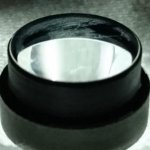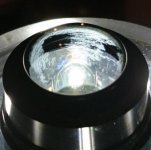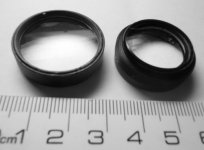That's very useful information, Marty, thank you.I use bucket loads of microscopy grade canada balsam at work to mount the small marine animals we work on. It is always yellow. Good optical cement is properly clear, with no tint, has a reliable even refractive index and is formulated to heat release reliably. The problem with balsam is you never know the grade or homogeneity of the product and the refractive index varies between batches and in the product.
Marty
You are using an out of date browser. It may not display this or other websites correctly.
You should upgrade or use an alternative browser.
You should upgrade or use an alternative browser.
Is DIY splitting cemented lens elements possible?
- Thread starter Puggie
- Start date
- Latest activity Latest activity:
- Replies 36
- Views 3K
Freakscene
Obscure member
acquire some releasable optical adhesive from somewhere (any specific recommendations in the UK)
https://www.edmundoptics.co.uk/f/norland-optical-adhesives/11818 or search the web for optical adhesive UK. The Norland 60 and 61 will release in methylene chloride even when fully cured. If you plan to go to the arctic the 61 is meant to be better, but plenty of great photos have been taken all sorts of very cold places with lenses cemented with balsam, which is theoretically a terrible very cold weather adhesive.
I had some Zeiss optical adhesive I’d donate, but some time between when it was given to me and now it turned into, well, for want of a better description, a very aspherical element.
Does that sound like a reasonable way to go about this?
Yes, entirely. Good work for planning it at all, actually.
Marty
Murray Kelly
Well-known
I have a sacrificial Canon 1.8 50mm here which was originally on a LTM. The rear cluster is OK but the front is not. Postage down to you.
PM me.
PM me.
Puggie
Established
So I have uploaded a couple of pic of the offending element. The fungus is between the two bonded surfaces. This lens group is the second and third pieces of glass from the focal plane (best description I can think of) just before the iris. they are accessed by removing the rear most ring, then the whole lens block drops out of the barrel. then if you unscrew the rear most section of the block, you have the rear three lenses. Then this bonded pair unscrews from the front of that set of three (confused yet)!
Murray has kindly offered me a better copy of this lens group, I still intend to try and rectify this one, just to see what can be done.
Murray has kindly offered me a better copy of this lens group, I still intend to try and rectify this one, just to see what can be done.
Attachments
Freakscene
Obscure member
That’s not fungus.
Marty
Marty
Puggie
Established
That’s not fungus.
Marty
OK then... its between the lens elements, so what is it?
Admittedly I thought someone had had a quick go at cleaning it (assuming being a canon ltm, it may fog like my 1.2 does) and done a poor job, this being some residue on the surface of a lens element. but its not, its between two cemented pieces of glass. Its not the spidery web looking residue normally associate with fungus, neither does it look like the 'bubble' I've seen of balsam separation I have on an old schneider 90mm f8 LF lens. I thought is was a fungus,but just a different propagation through the lens balsam as it was between layers of glass not just on the surface as I had seen before. Pics are crops from an old phone cam too so apologies they are not the clearest.
So please enlighten me, what issue do I have here?
Murray Kelly
Well-known
Puggie
Established
I believe the one on the right is the one I have uploaded, might have to take another couple of pics and measure the diameter and height this evening to check. My lens is the Canon 50mm f1.8 III (like this link https://global.canon/en/c-museum/product/s48.html). I believe the previous version II of this lens with 11 blade diaphragm (mine is the 8 blade) is of identical optics.
I will measure up the element diameters and heights this evening and post, so you can confirm your element is the same physical size.
I will measure up the element diameters and heights this evening and post, so you can confirm your element is the same physical size.
Freakscene
Obscure member
OK then... its between the lens elements, so what is it?
Admittedly I thought someone had had a quick go at cleaning it (assuming being a canon ltm, it may fog like my 1.2 does) and done a poor job, this being some residue on the surface of a lens element. but its not, its between two cemented pieces of glass. Its not the spidery web looking residue normally associate with fungus, neither does it look like the 'bubble' I've seen of balsam separation I have on an old schneider 90mm f8 LF lens. I thought is was a fungus,but just a different propagation through the lens balsam as it was between layers of glass not just on the surface as I had seen before. Pics are crops from an old phone cam too so apologies they are not the clearest.
So please enlighten me, what issue do I have here?
It’s separation, but from balsam autdegradation rather than from a breakage or bubble. Balsam gets hard over time unevenly which creates internal shear forces that pull it apart. When this happens inside rather than from the edges this is what it looks like. It’s also possible that when the cleaning was attempted a very small channel formed from the edge inwards and the solvents made the separation worse. All this, further, is good reason not to use balsam to fix it.
You won’t get fungus growing from inside cemented multi unit groups. There is no way for fungal spores to get in, and when fungus does grow it has very distinctive mycelia with a branched structure, rather than the irregular pattern you can see here.
Irrespective of the problem, the fix is to separate the elements, clean away the old adhesive, clean and polish the surfaces and re-glue the cleaned elements.
Marty
Puggie
Established
I need to find my sheet of 6mm PTFE and cut some jigs then 🙂
thanks for the school lesson 🙂
thanks for the school lesson 🙂
Freakscene
Obscure member
I need to find my sheet of 6mm PTFE and cut some jigs then 🙂
thanks for the school lesson 🙂
Sorry if it sounded like a lecture.
Just let us know how you go when you attempt the repair!
Marty
Puggie
Established
Sorry if it sounded like a lecture.
Just let us know how you go when you attempt the repair!
Marty
No it was meant in all seriousness, I've learnt something new, I'm grateful for that. I sometimes come across as a bit blunt and abrasive, especially with written communication which misses out the wry smile and cheeky grin that end the statement... maybe I need to use more smilies😀
Mr_Flibble
In Tabulas Argenteas Refero
I have done it a few times on Petzval lenses and prisms that had become unglued.
In one case I used heat on a Petzval front group to melt the yellowed and cracked balsam. It had nearly turned opaque.
Luckily balsam becomes soft at slightly over 100C.
Seperated the elements by sliding them apart and breaking the cohesion of the balsam, then cleaned them off with thinner. Reglued the elements using Norland Optical cement.
In case of prisms I seperated them all by soaking them in thinner overnight.
They were already clean when they came out of the tray.
Again using Norland Optical Cement to reglue them.
Using a jig is a must.
In one case I used heat on a Petzval front group to melt the yellowed and cracked balsam. It had nearly turned opaque.
Luckily balsam becomes soft at slightly over 100C.
Seperated the elements by sliding them apart and breaking the cohesion of the balsam, then cleaned them off with thinner. Reglued the elements using Norland Optical cement.
In case of prisms I seperated them all by soaking them in thinner overnight.
They were already clean when they came out of the tray.
Again using Norland Optical Cement to reglue them.
Using a jig is a must.
FYI
At one of the sites previously mentioned, there are a couple of specialist solvents for dissolving lens cement and the smaller sizes may be transported by air apparently. Instructions for the general one still recommend heat. Fair enough I suppose. The maker knows best. Myself, if I was doing a lens that was valuable enough to me to be worth the effort in the first place—except as a learning exercise, perhaps, and there's much to be said for practicing on an inexpensive optic first—then, I think that if it was a Balsam-cemented lens, I would probably still give it the benefit of the doubt and leave it to soak for a couple of days in a clean container, first. This might do the trick possibly and even if not I reckon it would have to give the heating stage a head start.
Cheers
Brett
(Link)
https://www.optical-cement.com/cements/decementing/decementing.html#decement
At one of the sites previously mentioned, there are a couple of specialist solvents for dissolving lens cement and the smaller sizes may be transported by air apparently. Instructions for the general one still recommend heat. Fair enough I suppose. The maker knows best. Myself, if I was doing a lens that was valuable enough to me to be worth the effort in the first place—except as a learning exercise, perhaps, and there's much to be said for practicing on an inexpensive optic first—then, I think that if it was a Balsam-cemented lens, I would probably still give it the benefit of the doubt and leave it to soak for a couple of days in a clean container, first. This might do the trick possibly and even if not I reckon it would have to give the heating stage a head start.
Cheers
Brett
(Link)
https://www.optical-cement.com/cements/decementing/decementing.html#decement
nikarlo
Member
I've separated many cemented doublet. I get never lucky with solvent (either with canadian balsam glue, but was a very large doublet) also waiting for 10 days. I've used acetone and paint remover as norland instruction says.
I use low ramp heat soaking them in water or better in (olive) oil to reach more high temperature than water.
After separation i remove the glue with paint remover and i bond them again with norland 61 and a uv led lamp for nail paint.
I use low ramp heat soaking them in water or better in (olive) oil to reach more high temperature than water.
After separation i remove the glue with paint remover and i bond them again with norland 61 and a uv led lamp for nail paint.
Murray Kelly
Well-known
Puggie, did that lens ever turn up in the post?
Freakscene
Obscure member
And if you’re looking to work out what cement to use:
https://www.edmundoptics.com/resour...optical-adhesives/which-adhesive-should-i-use
Marty
https://www.edmundoptics.com/resour...optical-adhesives/which-adhesive-should-i-use
Marty
Similar threads
- Replies
- 9
- Views
- 636
- Replies
- 11
- Views
- 767
- Replies
- 4
- Views
- 620
- Replies
- 6
- Views
- 575




